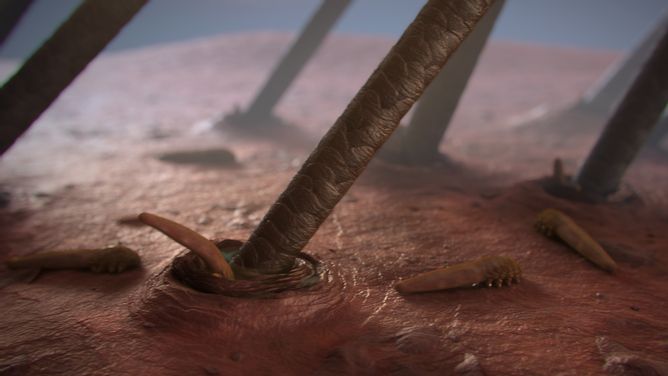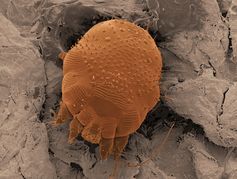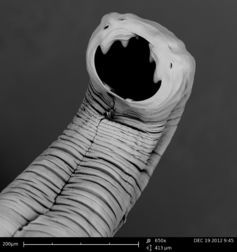
Life on Us: A Close-Up Look at the Bugs That Call Us Home (Op-Ed)

This article was originally published at The Conversation. The publication contributed the article to Live Science's Expert Voices: Op-Ed & Insights.
Many microscopic bugs and bacteria live on our skin and within our various nooks and crannies. Almost anywhere on (or even within) the human body can be home to these enterprising bugs.
Bugs affect us in a variety of ways: some bad, such as infections, but many good. From the passing of helpful bacteria from mother to baby, to the defence of our skin and intestine from disease-causing bacteria, our resident bugs are with us throughout the course of our lives.
A new two-part SBS documentary Life on Us looks at the bugs that make our body their home, using new tools to visualise these microscopic creatures. The first one-hour episode airs on SBS One at 8:30pm on Sunday, April 27.
Belly button bugs
Two of the main stories in the first episode focus on belly button bacteria and on the many varieties of lice.
A person’s belly button contains hundreds of bacterial species. The belly button is rarely well-washed and is a cosy place for these bacteria to settle. The bacteria here are probably not critical to our existence, but their presence does provide a quick and easy way to sample the great variety of bacteria living on the rest of human body.
Scientists can take a simple swab and quickly build up a profile for the sort of bacteria to which you’ve been exposed. As they build up profiles from many people, it becomes possible to tell the difference between good and bad bacteria. Your belly button bacteria can then help predict which diseases you might get and, if you do get one, how easily you may fight it off.
Sign up for the Live Science daily newsletter now
Get the world’s most fascinating discoveries delivered straight to your inbox.
The story of the human louse and its various specialities is also a good one – and is examined with stunning new electron microscopy videos. It is an evolutionary tale that explores how lice migrated across the body during our hairier past. It explains how they had to specialise to live in different environments as we became less hairy, as head lice can’t survive on any other part of the body.

The documentary links our loss of hair (to get rid of these parasites) with the lighter coloured skin of cooler climate people. It even looks at why we have some lice that came from our nearest simian neighbours – in this case, there must have been some close physical contact. Despite some aspersions cast on our early ancestors, this makes for a complex and interesting tale.
Unlikely roles
Many of the protective species of bacteria on the human body do their job by competing for living space with invading bacteria. Since the good bacteria were here first, they have an advantage and they are able to push the invading bacteria out.
These invaders might be bad bacteria like those responsible for food poisoning. Or it may be good bacteria such as those found in yogurt. In either case, the invaders are at a distinct disadvantage.
In the case of skin, those bacteria on the surface jealously guard their home and invading bacteria find it difficult to find nutrients and space to grow. Invading bacteria can also be attacked by existing bacteria using chemical warfare.
Unfortunately, as the documentary points out, once your skin is broken these invaders can get inside easily. Often this causes a local infection, but sometimes it causes problems throughout your body.
Bugs can also affect how we think. Among the fascinating tit-bits is the story of toxoplasmosis and risk-taking behaviour. Toxoplasmosis is an infection commonly picked up from cat poo that can cause serious harm to pregnant woman or other people with a weakened immune system.
In rats or mice, this infection is associated with behaviour that makes it more likely that they’ll be caught by a cat. In humans, it was associated with an increased likelihood of putting themselves in a risky situation.
Scientific rigour
The two-part series is a co-production between Australia and France, with the Aussie trailer heavy on monsters and dramatic music and the French version heavy on lingering shots of human bodies.
For the most part, this documentary delivers what is promised. It has beautiful (and sometimes gruesome) graphics showing what our bugs are up to. And there is a wide-range of interesting findings – some of which are sure to surprise even experts.

Where the first part of the series lets us down is its failure to deliver Australian science. Most of the science highlighted is being done overseas, while the commentary and human interest stories are of Australian origin. Fortunately, a sneak peek at the second part of the series promises a much stronger showing for Australian science.
Another shortcoming of this documentary is in the lack of depth and scientific rigour to which some of the facts are subjected. This can be forgiven in a documentary targeted at the general public. Nonetheless, it would have been nice to go into more detail and to give the pubic a sense of how well established some of the facts are.
I personally was interested in how gut bacteria colonise the vagina prior to birth. These bacteria form the basis for the infant’s own gut flora. However, this event was taken care of with a ten-second animation showing descending sparkles in the area of interest. When I looked further into the topic, it seemed clear that in some cases these colonising bacteria are not helpful – a point missed by the documentary.
I was also interested in the role of toxoplasmosis in human behaviour. However, the story of its tentative links with psychiatric disease was not discussed. The controversy and complexity around this topic could have provided more insight into the scientific method.
It’s important to appreciate that the scientific method produces advances that are not always grand leaps forward. Advances can come in fits and starts, with sometimes fierce debate in-between. The documentary is a good one, but as is often the case, there is more focus on the grand leaps, and less on the nitty-gritty of science.
Life on Us airs on SBS One at 8:30pm on Sunday, April 27.
Paul Bertrand receives funding from National Health and Medical Research Council for projects relating to gastrointestinal health and disease.
This article was originally published on The Conversation. Read the original article. Follow all of the Expert Voices issues and debates — and become part of the discussion — on Facebook, Twitter and Google +. The views expressed are those of the author and do not necessarily reflect the views of the publisher. This version of the article was originally published on Live Science.












